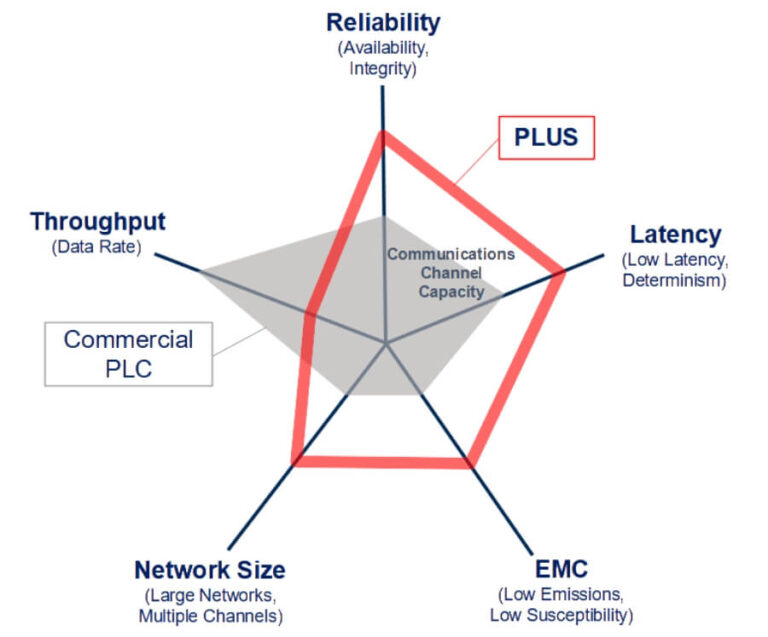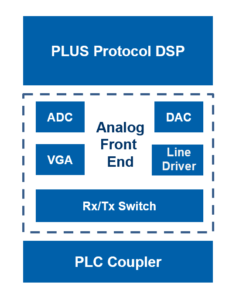PLC is a wired communication technology that carries data over power lines. The principal advantage of PLC is that it thus eliminates the need for dedicated data cabling, contacts, and connectors, thereby reducing costs, complexity, weight, etc. With PLC, data signals are modulated on power lines, completely independent of the underlying power signal. This means that PLC functions over any DC, AC or even non-energized power networks. The challenge for PLC is that it needs to be specifically designed for communications over wired channels that have not been designed for high-speed data communications, e.g. over unshielded wires in noisy environments.
Like in wireless communications, the term PLC refers to a broad range of diverse communication protocols. PLC technologies are typically divided into two different categories depending upon the band used by the communication signal. The narrowband PLC (NB-PLC) technology uses frequencies below 500 kHz and can provide maximum data rates up to several hundreds of kbps, however practical and regulatory limitations lead to a more typical achievable data rate of several tens of kbps. The broadband PLC (BPL) technology operates in the frequency range above 2 MHz. Consumer BPL technologies e.g. for home network applications can provide maximum data rates up to 500 Mbps.
plc-tec AG and its R&D partner Lucerne University of Applied Sciences and Arts (HSLU) have developed a PLC-based technology, the Power Line data bUS (PLUS), which specifically targets Mission-and-Time Critical (MTC) applications in aircraft, trains, and Smart Grids, among others.
The Physical Layer of PLUS has been developed according to the PLC standard IEEE 1901 and is therefore categorized as a BPL technology. What really makes PLUS applicable for MTC applications is the robustness of its communication protocols to deal with harsh channel conditions (i.e. channel distortions and noise) while supporting low-latency and deterministic protocol behavior.
Avionics was the first application area of PLUS, for which PLUS AVIONICS has been developed. The second area was rail applications for which PTB and PCN were developed. Driven by the first application the focus on the PLUS protocol design was from the beginning on maximizing reliability, reducing latency, and providing deterministic behavior. These design goals are different from other commercial PLC technologies which include much dynamic behavior to support plug-and-play and high bandwidth applications. PLUS not only targets a communications protocol which meets the necessary functional and performance requirements, but also provides design assurance as is required for safety-critical applications. Therefore, PLUS’ USP is in enabling PLC specifically for use in MTC systems such as an avionics data bus.
A MTC data bus must fulfil several performance requirements as shown in the figure below. The available channel capacity is the main factor for determining if these performance requirements can be met. However, this is a multi-goal optimization problem, where optimizing one of the axes will lead to a negative influence on the others.
Commercial PLC technologies (represented by the grey area in the figure below) maximize throughput at the cost of the other performance metrics. However, these technologies are largely non-deterministic meaning that in the best case the throughput may be very high (e.g., several hundreds of Mbps), but in the worst case the throughput will be very low or even zero. Achieving deterministic behavior requires proper design considerations.
The PLUS technology follows a different design approach. More weight is placed on maximizing reliability, reducing latency and achieving EMC compliance. This is represented by the red band in the figure below. In most scenarios it is also necessary to support larger network sizes. Accomplishing these optimization goals inherently leads to an overall reduction in the achievable throughput. However, PLUS provides deterministic behavior which is a strong requirement for MTC applications.




plc-tec is pursuing three major innovations, together with various research partners, in particular HSLU.
plc-tec has complete control over the processing of the high-fequency PLUS signals to address and implement further functions which add value to the communication use case of PLUS.
This enables innovative and cost-effective solutions for joint communication and sensor technology in powerlines.
PLUS-TimeSync
PLUS-TimeSync was originally developed for PLUS Smart Grid
PLUS-Time-Sync is used for the PLUS Train Topology Discovery (TTD) in PTB
PLUS-Time-Sync is available to be further employed for any further innovative applications.
Power System Diagnostics with the high-frequency PLUS Physical Signal providing additional information about the condition of the powerlines through which they run:
2025 plc-tec.ch – plc-tec AG | ALL RIGHTS RESERVED – IMPRESSUM | UMSETZUNG WEBTOTAL.INFO